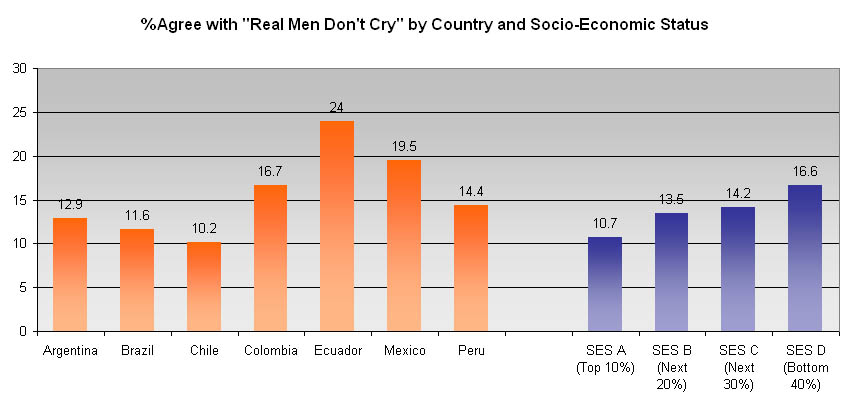
(source: 2003 TGI Latina)
Real Men Don't Cry in Latin America
Who are the real men? There does not seem to be a universally set of strictures about what real men do in order to qualify as such. Instead, there seems to be a lot of things that real men are not meant to do, as in
Within this list, the proscription against crying seemed to be most pervasive. In 1972, Ed Muskie lost his presidential bid when he cried in front of reporters in reaction to a news report that was critical of his wife. This was the wimp factor that made him unfit for the presidency.
The principal method of communication among human is speech. The written text is a way of codifying spoken words. Other than speech, body language is also important, and crying is a potent method of expression through the body. Jeffery Kottler, the author of The Language of Tears, posits that crying is the most potent form of emotional expression that covers a range of feelings --- sadness, despair, depression, sentimentality, joy, frustration, anger, relief, anxiety and awe. Tears are 'riveting' because 'things stop' when someone starts to cry, and tears lend power and authenticity to the crier.
The idea that real men don't cry is undoubtedly tied in with the machismo tradition (see Machismo in Latin America). The Dictionary of Mexican Cultural Code Words reports "... machismo meant the repudiation of all "feminine" virtues such as unselfishness, kindness, frankness and truthfulness. It meant being willing to lie without compunction, to be suspicious, envious, jealous, malicious, vindictive, brutal and finally, to be willing to fight and kill without hesitation to protect one's manly image. Machismo meant that a man could not let anything detract from his image of himself as a man's man, regardless of the suffering it brought on himself and the women around him. ... The proof of every man's manliness was his ability to completely dominate his wife and children, to have sexual relations with any woman he wanted, to never let anyone question, deprecate or attempt to thwart his manhood, and never to reveal his true feelings to anyone lest they somehow take advantage of him." Thus, real macho men never ever cry.
We now cite some survey data from the 2003 TGI Latina study. This is a survey of 53,566 persons in Argentina, Brazil, Chile, Colombia, Ecuador, Mexico and Peru during 2003. Within this survey, the respondents were shown the statement "Real Men Don't Cry" and their opinions are shown in the following pie chart. Notwithstanding the reputation of Latin America as being the original home of macho men, the majority of Latin Americans completely disagreed with the assertion.

(source: 2003 TGI Latina)
The scientific facts about crying include these known facts (Sob Story: Why We Cry, and How):
The post-puberty divergence between men and women may be a matter of different physiological development. More likely, it would seem to be the consequence of acculturation that imposes a stigma upon men who cry. In the following two charts, we show the agree rates (either 'completely agree' or 'somewhat agree' with the statement 'Real Men Don't Cry') by various population subgroups. From the first chart, we see that there are significant differences among the Latin American countries. The agree rates by socio-economic status in the first chart and by education in the second chart would suggest that social upbringing and education make it more acceptable for men to express their emotions. As for the agree rates by age/sex, it is clear that men are more concerned about women about this issue of apparent masculinity. The highest agree rate occurs among male teenagers, who are at the age where the social pressure is greatest with the act of crying as the separator between real men and mere boys.

(source: 2003 TGI Latina)

(source: 2003 TGI Latina)
(posted by Roland Soong, 12/23/2003)
(Return to Zona Latina's Home Page)